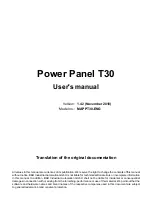
SECTION 6 PREVENTIVE MAINTENANCE
_______________________________________________________________________
6-5
•
PASS - An electrode passes if the impedance for that electrode is less than 7.5
kilo ohms. The ground electrode (element #2) must be less than 30 kilo ohms to
pass.
•
HIGH - An electrode is labeled “HIGH” if its impedance value is above 7.5 kilo
ohms. As long as the combined impedance of electrodes #1 and #3 and the
combined impedance of electrodes #1 and #4 are less than 15 kilo ohms, the
sensor check will be considered successful.
•
NOISE - If the signal from the electrode goes beyond the measurable range, the
label “NOISE” displays.
•
LEAD OFF - If the impedance check indicates that the electrode is not in
contact with the patient, the label “LEAD OFF” displays.
6.
If the Sensor Check is successful, repeat the test
by pressing the
[SENSOR
CHECK]
soft key. The Sensor Check Graphic Screen displays. During the test
sequence, flex the cable and connections at the PIC/SENSOR, and PIC/BISx
connections. Note that gentle flexing of these cables and connectors should not
cause the Sensor Check to fail.
NOTE:
Sensor Check is used in clinical application as an indicator of the patient’s
skin conductivity. When used with a Sensor Simulator or Test Sensor, the
Sensor Check serves to test the cable conductors of the BISx and PIC, and
the status indications noted above indicate the ability of the BISx and PIC to
conduct the sensor check signal. Values that are too high indicate a need to
investigate and possibly replace the PIC or BISx.
Expected Impedance Values
Sensor Simulator Values
Test Sensor Values
Electrode #
Typical
Range
Electrode # Typical
Range
1
5 K Ohms
4-6 K Ohms
1
1 K Ohms
1-2 K Ohms
2
10 K Ohms
8-17 K Ohms
2
1 K Ohms
1-3 K Ohms
4
4 K Ohms
3-5 K Ohms
4
1 K Ohms
1-2 K Ohms
3
3 K Ohms
2-4 K Ohms
3
1 K Ohms
1-2 K Ohms
Содержание BIS VIEW
Страница 2: ......
Страница 4: ......
Страница 10: ...iii ...
Страница 78: ...SECTION 8 SERVICING THE BIS VIEW MONITORING SYSTEM 8 16 ...
Страница 99: ......















































